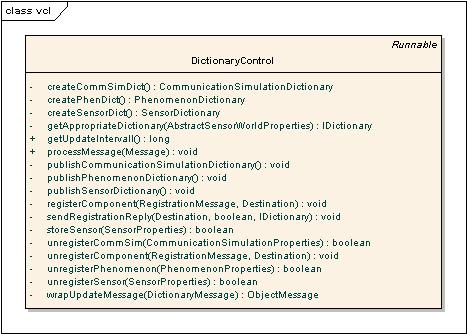You are here: Wiki>SensorWeb Web>SensorWorld>VirtualCommunicationLayer (28 Aug 2008, SimonJirka)Edit Attach
Virtual Communication Layer
The VCL encapsulates the communication between all components and is responsible to deliver all messages that need to be exchanged. It provides funtions to determine which message has to be received and wrapps Sensor World Messages (basic message type used in the simulation) into a format for sending via the network. The VCL should provide high performance to allow multiple working components like sensors or phenomenons. It simulates the conditions that exist in reality by using the CommunicationSimulation.Main components of the simulation The interface to the virtual communication layer is a Common Connector which provides methods for receiving and sending messages. Important tasks for the Common Connectors are:
- convertion of the messages between Sensor World Messages used in the simulation and communication system specific formats for the transfer in the messaging system
- messaging mapping: the Common Connector distinguishes messages according to their destinations
Messaging implementation
For the message transport the virtual communication layer relies on the messaging system MantaRay. MantaRay is a implementation of JMS (Java Message Service - http://java.sun.com/products/jms/) and will be used to make messaging traffic possible in SensorWorld. JMS provides two different communication model:- Topics allow one to many messaging, a publish and subscribe principle
- Queues are used for one to one, i.e. send and receive, communication.
Dictionary System
Every component within the simulation possesses a dictionary to deal with one important task of the virtual communcation layer: mapping the messages depending on the message type to the correct destination. More precisely a dictionary contains information about components in the system and their destinations at every time. The dictionary control component forms the centralised communication , which was chosen because of the difficulty to guarantee that all instances have the same knowledge at every time about the sensor network. Regarding the differences between sensor, phenomenon and communication it is necessary to differ between 3 types of dictionaries.- Sensor Dictionary
- Phenomenon Dictionary
- Communication Simulation Dictionary

Virtual Communication Layer Structure
- VCL - root package for Virtual Communication layer contains the dictionary control and main class of the vcl
- Common package contains all other important classes for the virtual communication layer
- ConnectorPackage - contains connecting classes between components and communication layer
- DictionaryPackage contains classes and messages for management of destinations (topics and queues), especially dictionaries for every component
Use Cases
A short description of UseCases within the virtual communication layer, contains images an detailed descriptions.| I | Attachment | Action | Size | Date | Who | Comment |
|---|---|---|---|---|---|---|
| |
VirtualCommunicationLayer.jpg | manage | 50 K | 15 Feb 2007 - 15:09 | UnknownUser | uml class diagram |
Edit | Attach | Print version | History: r11 < r10 < r9 < r8 | Backlinks | View wiki text | Edit wiki text | More topic actions
Topic revision: r10 - 28 Aug 2008, SimonJirka
Legal Notice | Privacy Statement
 Copyright © by the contributing authors. All material on this collaboration platform is the property of the contributing authors.
Copyright © by the contributing authors. All material on this collaboration platform is the property of the contributing authors.
Ideas, requests, problems regarding Wiki? Send feedback
 Copyright © by the contributing authors. All material on this collaboration platform is the property of the contributing authors.
Copyright © by the contributing authors. All material on this collaboration platform is the property of the contributing authors. Ideas, requests, problems regarding Wiki? Send feedback


